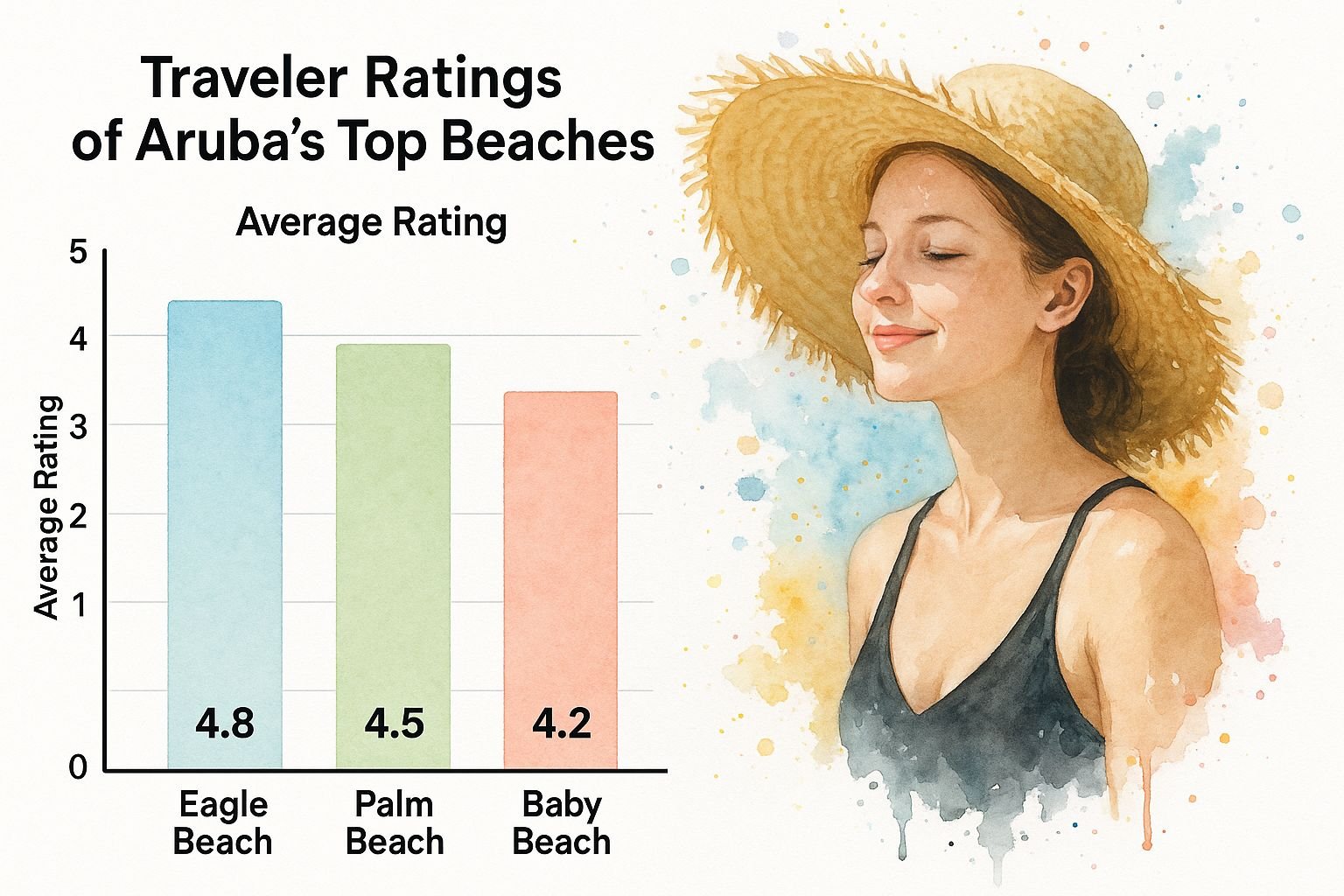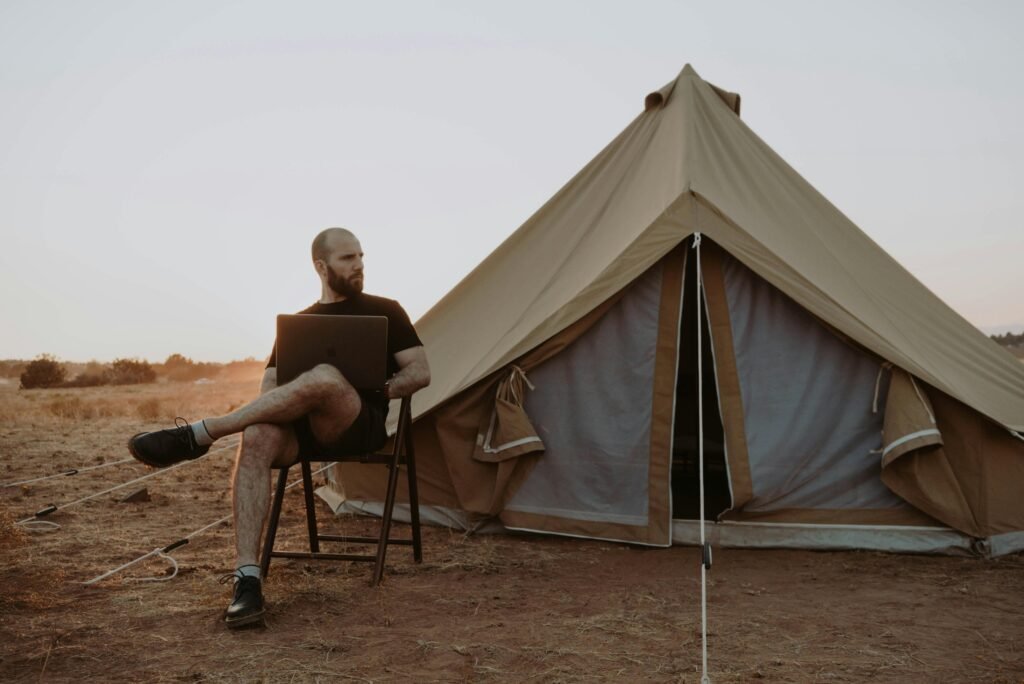Welcome to your complete guide to Aruba, the "One Happy Island." I've been lucky enough to visit this gem many times, and it never fails to impress. It's a place where you can count on sunshine pretty much every day, the beaches are genuinely world-class, and the vibe is just… happy. It's the perfect spot for a romantic trip or a big family holiday, especially since it sits safely outside the Caribbean's hurricane belt.
Why Put Aruba at the Top of Your Travel List?

Picture this: you're on an island where the average temperature hovers around a perfect 84°F all year, and the local motto isn't just a saying—it’s how people live. That's Aruba. It’s more than just another pretty Caribbean island; it's a place that’s genuinely built around making sure you have an incredible vacation.
What I love most is the island's dual personality. The west coast is what you see on postcards—calm, turquoise waters lapping against powdery white sand at famous spots like Eagle Beach and Palm Beach. It's pure relaxation. But then you have the east coast, which is a whole different world. It’s wild, rugged, and desert-like, with waves crashing against dramatic cliffs and natural bridges carved by the sea.
Something for Absolutely Everyone
This island of contrasts means you can tailor your trip to be exactly what you want. It truly delivers, no matter who you're traveling with.
- Looking for adventure? Grab an ATV and tear through the starkly beautiful landscapes of Arikok National Park, or find a hidden cove for some unforgettable snorkeling.
- Bringing the kids? The calm, shallow waters of Baby Beach are perfect for little ones, and a visit to the Butterfly Farm is pure magic.
- Need a romantic escape? It doesn’t get much better than a sunset dinner cruise, a private cabana for two, or just a simple walk along the shore at dusk.
It's Not Just About the Beaches
As stunning as the coastline is, the island’s soul is found in its culture. You can see the Dutch colonial influence in the colorful buildings of Oranjestad, and you can taste the blend of traditions in the local food, which is packed with fresh seafood and unique flavors.
Aruba's reputation as a premier destination is well-earned. Its knack for delivering a safe, consistently high-quality vacation has made it a go-to for travelers from all over the world who just want a guaranteed sunny escape.
The numbers back this up. In 2019 alone, Aruba saw nearly 2 million international visitors stay overnight—an incredible figure for an island of its size. Tourism isn't just a part of the economy; it is the economy, making up over 43% of its GDP. You can dive deeper into Aruba's tourism trends and economic impact if you're curious. This guide is here to help you discover the best of it all.
How to Plan Your Aruba Trip
Turning that dream of an Aruban getaway into a reality is a lot easier than you might think. With just a little bit of planning, you can set yourself up for a completely smooth, stress-free vacation. This part of our guide will walk you through the essential steps, from picking the perfect time to go to figuring out how to get around once you’re there.
First things first: timing. Aruba is incredibly lucky to sit just outside the Caribbean’s main hurricane belt, which makes it a fantastic destination any time of year. Still, the island has distinct travel seasons that can make a big difference for your wallet and your overall experience.
Choosing The Best Time To Go
The biggest decision you'll make is whether you want the high-energy buzz of peak season or the more laid-back, budget-friendly vibe of the off-peak months. Each has its own charm.
- Peak Season (December to April): This is when Aruba is in full swing, offering a perfect, sunny escape from colder weather up north. You can expect gorgeous weather, but you’ll also see higher prices for flights and hotels, along with bigger crowds at the most popular spots.
- Off-Peak Season (May to November): I love telling people about these "shoulder season" months. You can find some serious savings and enjoy a much more relaxed atmosphere. While it's technically the "rainy" season, don't let that fool you—showers are usually quick, passing in a flash and leaving behind plenty of sunshine for the beach.
To make it even clearer, here’s a quick breakdown of what to expect during each season.
Aruba Travel Seasons at a Glance
| Factor | Peak Season (Dec-Apr) | Off-Peak Season (May-Nov) |
|---|---|---|
| Crowds | High | Low to Moderate |
| Prices | Highest | Lower |
| Weather | Dry, sunny, less humid | Sun with brief showers, more humid |
| Availability | Book well in advance | More last-minute options |
Ultimately, the choice comes down to what you value more: guaranteed perfect weather or a better deal with fewer people around. If you’re looking for value, the off-peak months are an incredible opportunity to experience everything the island has to offer.
Logistics Made Simple
Once you've nailed down your dates, it’s time to sort out the practical details. The good news? Aruba makes this part incredibly easy for visitors.
Currency: The official currency is the Aruban Florin (AWG), but honestly, you'll rarely need it. The US Dollar is accepted almost everywhere. You can comfortably use USD at hotels, restaurants, and tour stands without ever having to exchange money. Major credit cards are also welcome in most places.
Getting Around: After you land at Queen Beatrix International Airport (AUA), you have a few good options. Taxis run on fixed rates, which is great for predictability—a ride to the popular Eagle Beach or Palm Beach area will cost you around $28 to $31. If you want the freedom to explore on your own schedule, renting a car is an excellent and very popular choice.
Where To Stay
Aruba’s lodging scene is as diverse as its coastline. You can find everything from huge, all-inclusive resorts to charming little vacation rentals. There really is a perfect spot for every kind of traveler.
Lately, we've seen a huge spike in people choosing rental platforms. In the last year alone, there were about 4,150 active Airbnb listings on the island. It’s clear that more and more travelers want a more local, authentic experience. The average stay of 5.7 days lines up with the classic week-long Caribbean vacation, and it seems February is the most popular month for visitors. For a deeper dive into these numbers, you can explore the Aruban tourism and accommodation trends on Airbtics.
If you're just starting to map out your trip, getting these details sorted is a fantastic first step. For those who are new to this, we’ve put together a really helpful resource on how to plan international travel that covers all the bases.

As you can see from the ratings, all of Aruba's top beaches are highly loved. But the data doesn't lie—Eagle Beach consistently comes out on top as the crowd favorite, cementing its reputation as one of the best in the world.
Discovering Aruba's Best Beaches and Natural Wonders

Sure, Aruba's perfect weather and famously happy vibe are what get you on the plane. But it’s the island’s raw, stunning natural beauty that truly hooks you. From world-class stretches of white sand to a rugged, desert-like national park, Aruba serves up a dramatic contrast of landscapes that just beg to be explored.
Think of Aruba’s beaches as a spectrum of experiences. You've got the iconic, postcard-perfect shores known for their soft sand and buzzing energy. But then you have these quiet, secluded coves that are perfect for snorkeling or a peaceful family day. Let’s dive into the undisputed stars of the show first.
The World-Famous Shores of Eagle and Palm Beach
You can't talk about Aruba without mentioning Eagle Beach. It consistently lands on "best beaches in the world" lists, and once you step onto its sand, you'll immediately see why. It’s an incredibly vast expanse of powdery white sand, so wide you never feel on top of anyone else. This is where you come to find your spot under a palapa, relax, and admire the iconic, wind-sculpted Divi Divi trees against the turquoise water.
Just a bit further north, Palm Beach offers a completely different vibe. It’s got a more vibrant, energetic pulse. This is the heart of Aruba's high-rise hotel district, lined with lively beach bars, great restaurants, and every water sport imaginable. If you're looking for action—from paddleboarding to parasailing—Palm Beach is your playground.
Hidden Gems for Snorkeling and Family Fun
Beyond the two big names, Aruba’s coastline is dotted with smaller beaches, each with its own personality. Tracking these down is part of the fun.
- Baby Beach: Tucked away on the southern tip of the island, this spot is an absolute haven for families. The water is incredibly shallow, calm, and clear, forming a natural, protected lagoon. It's a safe and completely worry-free place for little kids to splash around.
- Arashi Beach: A real local favorite near the California Lighthouse, Arashi is a snorkeler's dream. The currents are gentle, the water is crystal clear, and it’s teeming with colorful tropical fish. You can expect fantastic underwater visibility on most days.
- Mangel Halto: For something more secluded and unique, make your way to Mangel Halto. Here, a dense network of mangrove trees opens up to calm, shallow waters hiding some of the island's best offshore snorkeling reefs.
These lesser-known beaches offer a fantastic break from the bustle of the main strips and give you a glimpse into the more tranquil side of island life.
Don’t be afraid to rent a car and just explore. Some of the best beaches in Aruba aren't the most famous ones. The most memorable moments often come from stumbling upon a quiet little cove you have all to yourself.
Exploring the Wild Beauty of Arikok National Park
When you pull yourself away from the coast, you'll discover an entirely different Aruba. Covering nearly 20% of the island, Arikok National Park is a protected wilderness of desert landscapes, dramatic cliffs, and fascinating geological formations. It’s an absolute must-do if you want to understand the island's full character.
The park's terrain is rugged, showcasing a surprising number of cacti and unique wildlife. I highly recommend a 4×4 vehicle to navigate the unpaved roads and get to the park's most incredible sights.
Within this protected area, two spots are absolute can't-miss experiences. The Fontein Cave offers a cool escape from the sun and a chance to see ancient Arawak pictographs on its limestone walls—a direct link to the island’s earliest people.
The other crown jewel is the Natural Pool, or "Conchi." Tucked away on the wild east coast, this stunning swimming hole is shielded from the crashing surf by a natural barrier of volcanic rock. The journey there is a true off-road adventure, but the reward—a refreshing swim in a secluded natural wonder—is more than worth the effort. It's one of the most unforgettable experiences you can have in Aruba.
Finding Unforgettable Adventures and Cultural Experiences

Sure, you come to Aruba for the beaches. But the real magic, the stories you'll be telling for years, happens when you venture beyond the sun loungers. Aruba’s heart beats in its thrilling adventures and its surprisingly rich culture. It's a place where you can spend the morning chasing an adrenaline rush and the afternoon wandering through centuries of history.
This is what makes the island so special—it's not a one-note destination. You can go full-throttle with water sports or simply soak in the vibrant Dutch-Caribbean atmosphere. It’s your trip, your pace.
Thrills on the Water and Land
If you've got an adventurous streak, you've come to the right place. Aruba’s legendary trade winds and crystal-clear waters are a natural playground for thrill-seekers from all over the world.
- Kitesurfing and Windsurfing: Head straight to Hadicurari Beach, known locally as Fisherman's Huts. This spot is the undisputed hub for wind sports. The constant breeze and shallow waters are perfect whether you're a total beginner trying to stand up for the first time or a seasoned pro landing your next big jump.
- Scuba Diving: What lies beneath the waves is just as incredible. Divers have plenty to explore, but the crown jewel is the SS Antilla shipwreck. This WWII German freighter is one of the largest and most impressive wrecks in the entire Caribbean.
- ATV and UTV Tours: To really get a feel for the island’s wild side, you have to go off-road. These guided tours tear through the cactus-studded landscapes of Arikok National Park, kicking up dust on the way to remote treasures like the Natural Pool.
For anyone who loves getting off the grid, you might also like our guide to the world's best adventure travel destinations.
Immersing Yourself in Aruban Culture
Adrenaline is only half the story. To truly connect with Aruba, you need to dive into its history and culture. These are the places that give the island its soul.
Your first stop should be Oranjestad. The capital city is a visual treat, with its brightly painted buildings that blend Dutch colonial design with a sunny Caribbean twist. It’s a photographer’s paradise and an incredible place to just wander and get lost for a few hours.
The best Aruba travel guide will always push you beyond the beach. Digging into the island’s history and local industries is how you connect with the real spirit of Aruba and its people.
From the capital, you can branch out to other landmarks that piece together the island's unique story, each offering a different window into its past.
Iconic Landmarks and Local Flavors
You can’t say you’ve really done Aruba without checking a few key spots off your list. These aren't just tourist traps; they are woven into the very fabric of the island.
California Lighthouse
Sitting at the island's northernmost point, the California Lighthouse delivers some of the most jaw-dropping panoramic views on the island. It was recently restored, so you can now climb all the way to the top. The reward? A stunning look at the rugged eastern coastline meeting the calm western sea. Pro tip: Go for sunset. You won’t regret it.
Aruba Aloe Factory
For over 125 years, aloe has been a huge part of Aruba's identity. Taking a tour of the Aruba Aloe Factory and Museum is a surprisingly fascinating experience. You get to see the whole process, from watching workers slice the fresh aloe leaves right out of the field to seeing the final skincare products being made.
Sunset Cruises
If you're looking for a more laid-back adventure, a sunset cruise is a quintessential Aruban experience. There's nothing quite like sailing along the coast while the sky explodes in shades of orange, pink, and purple. Most tours include drinks and snacks, making for a fun, breezy way to cap off the day.
By mixing these adventures and cultural stops in with your beach time, you’ll leave with more than just a tan—you’ll have a real feel for what makes this island so unforgettable.
Choosing Where to Stay and What to Eat
Figuring out where to stay and what to eat can make or break a trip. Thankfully, Aruba delivers on both fronts, offering everything from massive, glittering resorts to quiet boutique hotels. The food scene is just as varied, blending local traditions with global flavors. Let’s dive into how to pick the perfect spots for your vacation.
Believe it or not, Aruba's huge tourism scene is a relatively recent development. After a major oil refinery closed in 1985, the island's government went all-in on tourism. This sparked a massive building boom between 1986 and 1996, where the number of hotel rooms skyrocketed from 2,776 to 7,103. You can read more about this incredible shift in Aruba's tourism history on Aruba.com.
That pivot created the incredible variety of places to stay we see today, meaning there’s something for just about every travel style and budget.
Selecting Your Ideal Accommodation
Where you choose to stay in Aruba really sets the tone for your whole vacation. The island’s two main hotel zones, Palm Beach and Eagle Beach, offer completely different vibes, while other options have their own unique perks.
Palm Beach: The High-Energy Hub
This is the heart of the action. Palm Beach is lined with iconic high-rise resorts like the Hyatt, Marriott, and Hilton. If you want to walk out of your hotel and be surrounded by bustling restaurants, lively beach bars, and every water sport imaginable, this is your spot.
Eagle Beach: The Relaxed Retreat
Famous for its impossibly wide, white-sand beaches and iconic, twisted Divi Divi trees, Eagle Beach has a much more laid-back feel. It's home to low-rise boutique hotels and timeshares, giving you a quieter, more spacious beach experience that’s perfect for truly unwinding.
Your choice between Palm Beach and Eagle Beach really comes down to this: Do you want to be in the middle of a non-stop party, or are you looking for a more peaceful place to just kick back and relax?
All-Inclusive and Vacation Rentals
For a truly hands-off vacation, Aruba has some fantastic all-inclusive resorts where your food, drinks, and activities are all bundled together. On the flip side, vacation rentals give you more space and a kitchen, which is a great way to keep costs down. For more ideas on this, check out our guide on how to save money while traveling.
Savoring the Flavors of Aruba
Aruba’s food is a delicious mashup of Dutch, Caribbean, and South American influences. You can find everything from elegant fine dining with your toes in the sand to rustic shacks serving fish that was caught just hours before.
Here are a few food experiences you absolutely shouldn't miss:
- Fresh Seafood with a View: Places like Zeerovers and The Flying Fishbone are legendary. Zeerovers is a no-frills local spot where you buy the day's fresh catch by weight, and they fry it up for you right on a fishing pier. It doesn't get any fresher.
- Authentic Aruban Cuisine: Keep an eye out for keshi yena (a hollowed-out ball of cheese stuffed with spiced meat), rich stews called stobas, and savory fried pastries known as pastechi. This is the real taste of the island.
- Casual Beach Shacks: You can’t go wrong with places like Eduardo's Beach Shack for a quick, healthy lunch. They're famous for their incredible acai bowls, smoothies, and poke bowls served right on the beach.
- Dining on the Sand: So many restaurants, especially along Palm and Eagle Beaches, set up tables directly on the sand for dinner. It’s hard to beat a romantic sunset meal with the sound of the waves just a few feet away.
A quick tip: Always make reservations, especially for popular restaurants like The Flying Fishbone or if you’re traveling during the high season. Exploring the island’s food is one of the best ways to connect with the culture of "One Happy Island."
Building Your Perfect Aruba Itinerary
Aruba has so much to see and do that it's easy to feel a little overwhelmed when you start planning. The secret is to let your own travel style set the pace. Are you here to completely disconnect? To make incredible family memories? Or maybe you're chasing a thrill? A little bit of planning goes a long way in making sure every moment counts.
To get you started, I've laid out three very different ways to experience the island. Think of these as starting points—feel free to follow them exactly or, even better, mix and match activities to build an itinerary that’s uniquely yours.
The Five-Day Relaxing Beach Escape
This one’s for anyone whose main vacation goal is to find a good spot on the sand and completely check out from the real world. It’s all about slowing down and embracing Aruba's chill, tranquil side.
- The Vibe: Maximum relaxation, zero stress.
- What You'll Do: Spend your days lounging on the world-famous Eagle Beach, maybe indulge in a spa treatment at your resort, and take long, leisurely walks at sunset.
- Where You'll Eat: Evenings are for romantic, toes-in-the-sand dinners at legendary spots like The Flying Fishbone, followed by a quiet drink at a mellow beach bar.
The Seven-Day Family Fun Adventure
Packed with activities that kids and grown-ups will love, this itinerary is all about non-stop family fun. It’s a great balance of beach time and cool excursions that really show off the island’s playful personality.
The key to a great family trip is variety. You want to mix high-energy stuff like snorkeling with calmer, more educational stops like the Butterfly Farm. It keeps everyone excited and happy without anyone getting burned out.
With this plan, every day brings a new adventure. You’ll explore the super-shallow, kid-friendly waters of Baby Beach, hang out with vibrant winged creatures at the Butterfly Farm, and have a blast on a family snorkeling cruise. For more great tips on organizing your days, check out our guide on how to make a travel itinerary.
The Five-Day Thrill-Seeker's Journey
If the thought of sitting still makes you antsy, this high-energy itinerary is your speed. It’s built around Aruba's best adventures, both on land and in the water.
- The Vibe: Adrenaline and exploration.
- What You'll Do: Your days will be jam-packed with action, from tearing through the rugged desert landscape of Arikok National Park on a UTV tour to learning how to kitesurf at Hadicurari Beach. You’ll also get to explore the famous Antilla shipwreck on a scuba or snorkeling trip.
- Where You'll Eat: You’ll need to refuel, so think lively and casual. Hit up Zeerovers for the freshest catch you'll ever have or grab a quick, healthy poke bowl from Eduardo’s Beach Shack right on the sand.
Common Questions About Traveling to Aruba
Alright, let's tie up a few loose ends. Before any trip, there are always those nagging little questions that pop up while you're packing. Getting these sorted out ahead of time means you can hit the ground running as soon as you touch down on the island.
The first question I always get is, "Can I drink the water?" Yes, the tap water in Aruba is perfectly safe to drink! Seriously, it's some of the best you'll ever have. The island has a state-of-the-art desalination plant that turns seawater into incredibly pure drinking water. Feel free to fill up your bottle right from the tap and skip the plastic.
Logistics and Packing
What about money? The US Dollar is accepted pretty much everywhere. While the official currency is the Aruban Florin (AWG), you really don't need to exchange your money. Most places list prices in both USD and AWG for convenience.
When it comes to getting around, renting a car gives you the ultimate freedom. It’s the best way to find those hidden coves and local lunch spots on your own schedule. If you'd rather not drive, taxis are everywhere and operate with fixed, government-set rates, so there are no surprises when you get to your destination.
Planning a trip is more than just booking tickets—it's about protecting your investment. Getting a handle on your options is crucial, and our straightforward guide on what travel insurance covers can give you that extra peace of mind.
Finally, a few packing essentials to make sure you're ready for everything Aruba has to offer:
- Lightweight Clothing: Think linen, cotton, and other breathable fabrics. It's warm, but there's almost always a lovely breeze.
- Reef-Safe Sunscreen: The Caribbean sun is no joke. Protect your skin while also protecting the island’s delicate marine life.
- Reusable Water Bottle: A must-have for staying hydrated with that amazing tap water and helping to keep the island beautiful.
- Swimsuits and Cover-Ups: You’ll be living in these, moving from the beach to a poolside bar.
- A Light Jacket or Sweater: Evenings can get a little breezy, and restaurants often have the A/C blasting.
Ready to stop dreaming and start planning? At The People Travels, we create personalized, day-by-day itineraries based on your interests and budget. Discover your perfect Aruba adventure at https://thepeopletravels.com.




